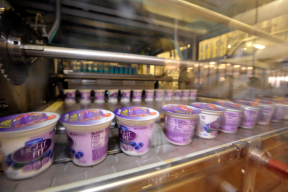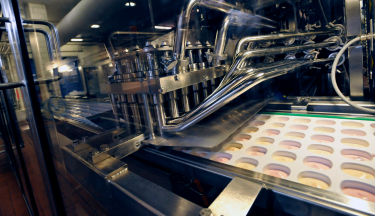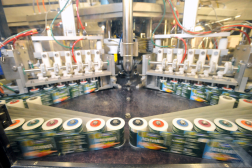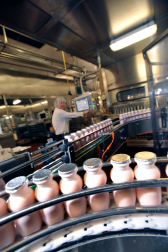

The decision to do away with overcaps actually made sealing slightly easier.
Now yogurt, in its many forms, is firmly in the American mainstream. And the Minster facility is Dannon’s biggest yogurt plant in North America.
The 336,000-square-foot plant sits on 29.5 acres in Ohio farm country. Each day, it turns in excess of 1.5 million pounds of milk into Dannon yogurt, Light & Fit yogurt, the children’s drink Danimals and Dannon’s new probiotic products, Activia yogurt and DanActive dairy beverages. This production pace ranks Minster third in volume among the more than 40 plants that Groupe Danone, Dannon’s French parent, runs worldwide.
As the largest-volume North American plant, Minster had long enjoyed a sort of privileged status within Dannon, simply because there was nothing nearby to compare with it. That led to a certain attitude of complacency among personnel. But the reality, plant executives say, is that among Danone facilities worldwide, Minster ranked somewhere in the middle.
“This plant has always been the biggest one in North America,” says John St. Clair, the plant’s quality and food safety manager. “As compared with [other Dannon North American plants], the bar for operational performance wasn’t necessarily very high. So while we always considered ourselves the best in the U.S., we didn’t compare well when benchmarked against all the operational performance indicators of our sister plants throughout the world.”
A combination of new products and new demands formed the motivation for the Minster plant to embark on a series of significant improvements. For instance, about two years ago, Dannon decided to make Minster share the responsibility for producing yogurt beverages like DanActive. Up to then, they had all been produced at the Dannon facility in Fort Worth, Texas. Splitting the production with Minster meant quicker access to Eastern markets-a critical consideration for products with a shelf life of about 50 days. But it required shifting around some lines and reducing their footprint.

Newly thermoformed cups are filled before being sealed and cut apart. Dannon is looking to increase the use of thermoformed-on-site cups, which are more efficient than premade ones.
Results emerging
Other improvements came in, such as cup thermoformers that eliminate the hassle of storing and handling preformed cups. More than one third of the total plant capacity has been upgraded or replaced over the last three years, says plant director Didier Menu. This required a significant effort for the team on-site to learn how to operate the new technology. The results are just starting to emerge, Menu says-and to become clear to the plants’ workers.“The challenge was to get people involved with the new plan,” Menu says. “I can [now] say I believe we are getting there. But if we had met six months ago, I would have said, ‘This is our plan, but I’m not quite sure.’ But people are starting to see that all these changes are bringing benefits. They are starting to believe our plan and results are showing.”
With operators on the manufacturing floor, the formula the Minster plant uses is QCDM: quality, cost, delivery and motivation. The plant ties these concepts to specific metrics and posts the results, for each line, in the plant’s hallways. Quality translates to the amount of product removed from each line per shift; cost, to production efficiency (actual production divided by maximum throughput).
The plant produces about 100 stock-keeping units (SKUs). Planning is done on a batch basis. Each batch of yogurt is assigned a production order number. Plant execution software identifies and outputs the kind and amount of all the materials needed to package the batch. From raw materials ordering through distribution, this system is integrated with SAP.
With the large number of SKUs produced, plant managers try to hold changeover to a minimum. (The plant operates 24/7, although not all lines run all the time.) Most changeovers have to do with flavors and product types. When packaging machinery needs to be adjusted-for instance, to change from four-packs to six-packs of 4-ounce cups, or to switch from single-layer to double-layer cases-it’s done with a combination of manual adjustments and servo controls.

Thermoformed cups use in-mold labels, cut from rollstock, which confers more flexibility than pre-labeled containers.
Packaging operations
The plant is divided into five major areas, two of which directly concern packaging: the packaging building, with about a dozen lines-most for cups or tubs and a few for bottle production-and a facility leased and operated by Graham Packaging, which produces bottles for Danimals and DanActive in a “through-the-wall” arrangement. One of the most significant transitions at the Minster facility, which is still ongoing, is a move from preformed polystyrene cups to cups thermoformed on site. Minster now has several thermoformed PS cup lines, which is the company’s fastest area of growth. Thermoforming the cups on site has several advantages. The half-ton roll of thermoformed plastic lasts for several hours of production, freeing workers from the tedium and less optimal ergonomics of loading stacks of cups into hoppers. Rolls of plastic are much easier to store than stacks of preformed cups. Thermoformed cups use in-mold labeling, conferring significant scheduling flexibility over preforms, which must be pre-labeled. And thermoformed cups have two important environmental advantages: they have walls about 25% thinner than preformed ones, and they are easier to transport, this lowering the packaging’s overall “carbon footprint.” One of the thermoforming lines fills 4-ounce cups of Activia. The plastic sheet unrolls into a web that flows into the thermoform-fill-seal system from Arcil. The plastic web is heated and positioned over a grid of molds on arms that rotate beneath the web. The molds have already had labels inserted into them, cut from a separate web. Plungers descend and push the heated plastic into the molds, forming a block of cups that travel below a cluster of filler nozzles. Activia, which is fermented in a tank like other blended yogurts, gets filled and the lid is applied and heat-sealed, after which the block of cups is cut into four- or six-packs.
The Minister plant recently started producing yogurt drinks, as part of Dannon's strategy to make its three major U.S. plants into regional facilities.
Cup set parameters
Traditional yogurts, which are fermented in the cup, have a different filling process. Quart tubs and 6-ounce cups are filled in preformed PP containers on a system from Gasti. Cups are assured to be clean before filling with blasts of sterilized air. The cups and tubs enter a HEPA (high-energy particulate arresting)-filtered air chamber, and cups and tubs are hot-filled with cultured milk. After filling, the cups and tubs are sealed. Fruit-on-the-bottom products have fruit deposited in the empty containers by separate nozzles before the yogurt. These products, as opposed to the blended ones, are then incubated, which turns the cultured milk into the viscous yogurt.When Dannon stopped using overcaps for most of its 6-ounce products three years ago, it not only saved about 3 million pounds of plastic a year, it made sealing easier. The cups have a slight raised ridge of plastic running around their rims, and the foil seals have a coat of lacquer around their edge. Heat sealing attaches the seals to the cup and tub rims. When Dannon was using overcaps, the heating had to fall within a window: Too much heat would cause the container’s rim to expand too much and make it hard to get the overcap on; too little heat meant the rim’s expansion was inadequate, leaving the overcap loose and liable to fall off.
For the 4-ounce blended Activia cups and other products of that size, paperboard sleeves are applied by a system from the Aries Packaging division of MWV (previously MeadWestvaco). A rotary inserter uses suction cups on a wheel to pluck the sleeves one at a time from a stack in a magazine and position them over each cluster of four, eight or 12 cups. A series of crimpers, folding wheels and guide rails fold and seal the sleeve around the cups.
Yogurt in a bottle
The bottling lines, which handle Danactive probiotic and Danimals children’s drinks, use high-density polyethylene (HDPE) bottles produced by Graham Packaging in a facility Graham leases and operates on the Minster campus. The bottles are conveyed from that building to the packaging area, where they are lifted from a hopper, then set into platens and filled in a system from Ermi Agroalimentaire. Foil seals are set on parallel rows of platens and plucked off, two rows at a time, by long arms of suction cups, which then slide over to the rows of filled bottles. The seals are then thermally attached to the bottles.For most of the 4-ounce cups, secondary packaging consists of wraparound corrugated, applied by an Axiom case packer from Douglas Machine. The corrugated has holes on each side. The holes allow airflow that cools the individual yogurt cups when the boxes spend several hours in a cooling tunnel-a process that helps set the product at the proper viscosity. By the same token, the ram-style palletizers, from Priority One, are programmed to stack the boxes in a pattern that maintains the airflow. “Because all of our products have live, active cultures, we try to cool them down as quickly as possible,” St. Clair says.
Some of the packaging lines use automatic guided vehicles (AGVs) from HK Systems to take the pallets to the Lantech stretch wrappers. The AGVs do not use floor-based guidance strips; a post-mounted transceiver sends laser signals to each of the three units, guiding them between the palletizers and the stretch wrappers.
Solo operator
The AGVs are part of a drive to refocus manpower to improve productivity. In that respect, the role of operators is being focused on value-added processes. A new line has just been started with this concept and ultimately will be operated by a single person between the filler and the palletizer. Dannon believes in the model of the soloist line operator supported by a team.Teamwork will be the key to doing that, Menu says: “To have one person per line, you need to have an operator like a race car driver-however, that operator needs a high-performance support team helping them.”
As an example, Menu says, operators under the old model have to cart packaging waste and recyclables to the bins themselves. The new line is serviced by a “waste and recycle train”-an electric cart carrying a chain of small, wheeled bins, each one carrying a load of corrugate, plastic trimmings and so on.
Half-jokingly, Menu adds that keeping the bins small has another benefit: “When you reduce the size of the bin, people find a way to reduce the amount of waste.” Menu concludes, in all seriousness, “All of these changes are bringing improvement to our employees, the environment and our consumers.”F&BP
<br><br><br>
FOR MORE INFORMATION
Arcil011-33-1-30-15-29-30
Aries Packaging
011-33-3-25-71-39-00;
Douglas Machine
320-763-6587;
Ermi Agroalimentaire, rep. by Geosaf
514-331-4147;
Gasti, an IWKA Co.
011-49-791-402-0;
Graham Packaging
717-849-8500;
HK Systems
800-HK-SYSTEMS
Lantech
800-866-0322
Priority One
800-387-9102
